The juniper mystery
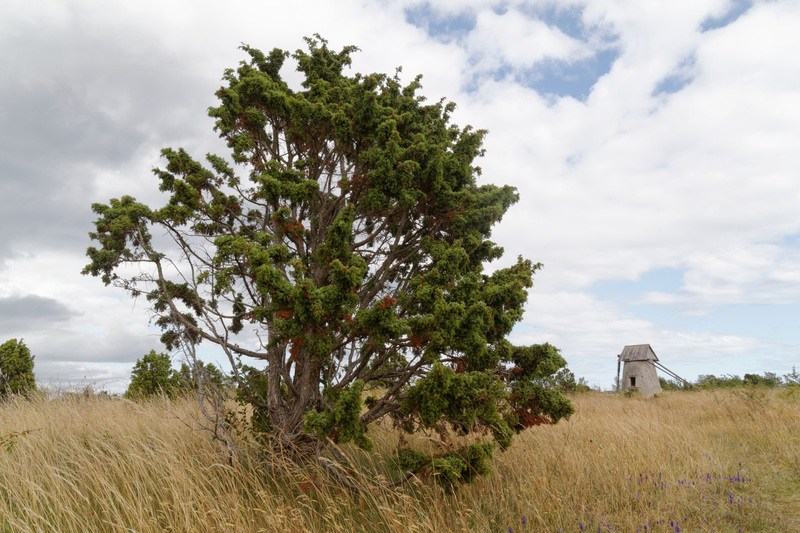
Juniper bush, Fårö, Sweden |
When I started looking at farmhouse ale back in 2010, one of the first things that struck me was that nearly everyone seemed to be using juniper. That was unexpected, since the beer literature generally has very little to say about juniper. Now, six years later, I'm beginning to realize that the international beer community has somehow managed to miss a huge story here.
For example, the Oxford Companion to Beer says juniper is used in the Nordic countries, and particularly in sahti. And that it's used in gin. That's pretty much it. The most comprehensive overview of additives in traditional brewing, Karl-Ernst Behre's 1999 paper[15], mentions that juniper has been used in Estonia. Again, that's it. Nils von Hofsten's jaw-droppingly erudite book on herbs in beer from 1960 briefly mentions juniper use in Sweden, but that's it[18]. And so on.
However, once I got a bit deeper into the subject I noticed that juniper was pretty much universal in Norwegian farmhouse brewing. And it's widely used on Gotland. And in sahti[19]. It was used by all the brewers I visited in Estonia. Then I visited Latvia, and what do you know, they were using it there, too. At this point Lithuania was beginning to look like the odd man out, since only a few brewers there are using juniper.

Sprig of juniper in the mash, Hiiumaa, Estonia |
I assumed that since it was used over such a huge area, from northern Norway to Gotland, Finland, and the Baltics, the use of juniper had to be an old, shared tradition. But when I looked at the ethnologists who'd studied this seriously, they totally disagreed.
Odd Nordland, the authority on Norwegian farmhouse ale, writes:
It is evident that juniper, as part of the strainer and as a basis of the extract [infusion], is an innovation in Norway. Juniper extract has been commonly accepted in fairly large areas, but the use of juniper in the strainer has not been adopted to the same extent. This is no more than one might have expected, as a juniper decoction had to be prepared in any case during brewing, to be used for washing and cleaning. It was already at hand in fact. But using juniper twigs in the strainer was an entirely different matter - this was not acceptable, as it was considered of great importance that the strainer was arranged according to ancient tradition.[1]
He seems to be arguing that because juniper was less common in the strainer than in the infusion, this shows that it's an innovation, because people were conservative about the strainer. That's a very odd argument, and it's the only one he gives, but it cannot be dismissed out of hand, since Nordland spent at least a decade studying the subject.
Another authority on the subject, Anders Salomonsson, claims the use of juniper in the strainer is a modern innovation caused by the introduction of modern farming equipment. The farmers used to strain the mash through long straw, but with modern harvesting there was only short, unusable straw, which made them replace the straw with juniper. He then does something very strange: he claims juniper in the strainer is very rare outside Gotland. But on the same page he notes it's been used in Norway and Finland. And he claims examples of juniper infusion outside Gotland are "as good as none." [20] This is obviously nonsense.
Still, this is two out of two authorities claiming the use of juniper is recent. The third, Räsänen, hasn't made any claims either way that I've seen[19]. That's pretty hard to argue with.

The beginning of Wilse's account, 1779 |
Looking at older sources I was surprised to see that Nordland and Salomonsson seemed to be right. Jacob Nicolai Wilse published an account of brewing in Østfold, Norway in 1779[21]. There's no mention of juniper in the recipe. Hans Jacob Wille did the same for Telemark, Norway in 1786[3]. No mention of juniper there, either. Nordland references J. A. Krogh, who writes of brewing with juniper in Nordfjord, Norway, 1813, so the use can't be that recent. Could it be that Wille and Wilse simply omitted the juniper? That seemed unlikely, because their accounts are pretty detailed.
Then I finally got hold of the Danish farmhouse ale survey responses and went through 123 of them, looking for information on herb use. 2 mentioned juniper. One was from Bornholm, which geographically is practically Sweden, so that hardly counts. The other was by a man who wasn't a brewer, so he'd asked a woman to help fill in the gaps in his knowledge. Nothing wrong with that, but the woman was Finnish. With 121 other accounts contradicting him, well, I'm tempted to dismiss this one as Finnish influence, leaving us with 0 accounts in Denmark proper.
Then I got hold of accounts of farmhouse brewing in Wales, England, and Scotland. Not a word about juniper there, either.
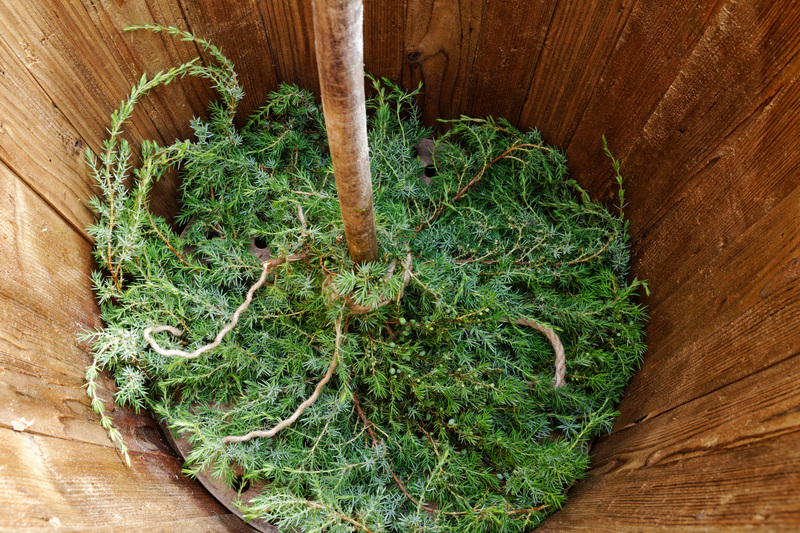
Juniper in the strainer, Aizpute, Latvia |
So juniper was clearly a Nordic and Baltic phenomenon, but how could it be so widespread and yet recent? Looking at the data I saw juniper used in nearly all Norwegian recipes (95%), but seemingly less elsewhere. Could it be that it began in Norway in the 17th or 18th century, or slightly before, and then spread with the expansion of the Swedish Empire into Finland and the Baltics?
That seemed both to fit the evidence, and at the same time to be awfully fast for a change in traditional brewing. I decided the only way to get an answer was to dig deeper. So I did.
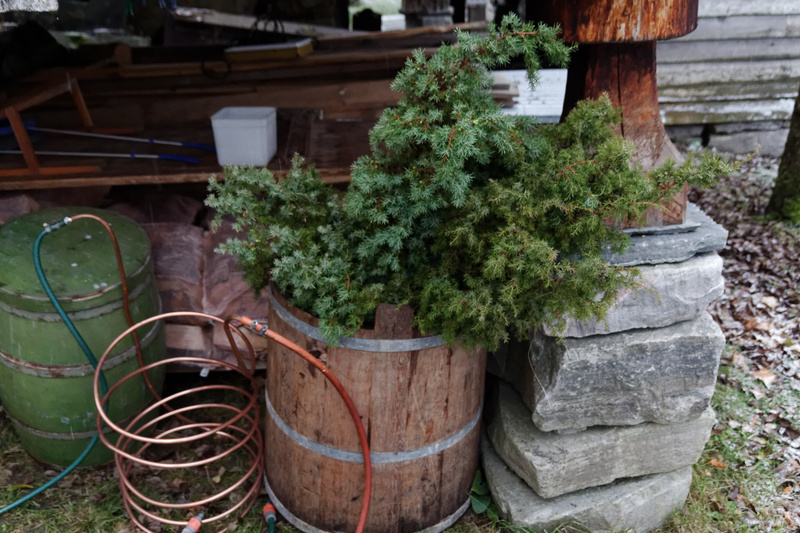
Juniper ready for use, Aga, Hardanger |
Let's go over the basic, well-known evidence first. Juniper is used a lot in Nordic and Baltic farmhouse ale. From my recipe database I get the table below. For countries other than Norway and Denmark the selection of accounts have various biases, so the percentages shouldn't be taken too literally for those countries.
| Country | % | Accounts |
|---|---|---|
| Norway | 95 % | 232 |
| Denmark | 2 % | 124 |
| Sweden | 55 % | 53 |
| Finland | 42 % | 38 |
| Estonia | 93 % | 15 |
| Latvia | 20 % | 5 |
| UK | 0 % | 5 |
| Lithuania | 25 % | 4 |
So clearly juniper usage was extremely widespread in the Nordic and Baltic countries. And the juniper was and is key to the character of these beers. In the Norwegian, Swedish, Finnish, and Estonian farmhouse ales I've tried hops are usually not discernible at all, while juniper is one of the main flavours. Odd Nordland acknowledged it as such by putting juniper in chaper 11 (Basic Flavours), while relegating hops to chapter 17 (Hops and other Flavourings)[1].
Norwegian farmhouse ale survey response NEG 13881 (Skodje, Møre og Romsdal) illustrates this very well. Asked what herbs they used in the beer he responds that they use no plants other than hops. Then, suddenly, he remembers that he's just written a couple of pages about how they use juniper for infusion and in the strainer, and adds that "but juniper was so to speak a fundamental flavour, along with malts and hops."
In Helsinki I managed to find two sahtis. The Finlandia tasted unbalanced sweet to me, but the Lammin Sahti has a sharp, bitter juniper note that cuts through the sweetness, balancing it wonderfully. The juniper was used the same way in Estonia, as far as I could tell, and also in Norway. And so on.
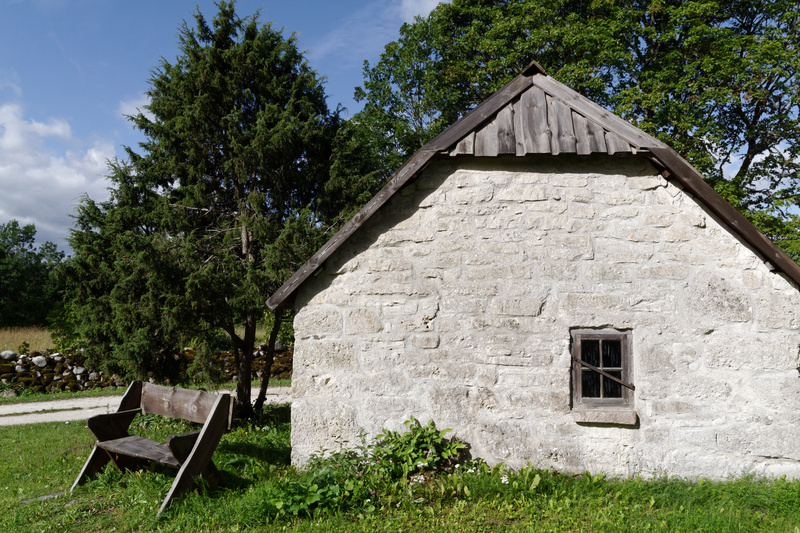
Juniper next to an old house, Muhu, Estonia |
Digging deeper I found Engelbret Mandt's account of brewing in Telemark, Norway from 1777[2]. He says the farmers use juniper in the beer, so clearly Wille 1786[3] left something out. Then I find that Johan Molbech's book[4], published in Copenhagen 1796 also claims the use of juniper in beer is common (he doesn't say where). Just recently, I discovered that Reinerus Broocman's account of Estonian brewing from 1736[5] says juniper infusion was common there, too. At this point the idea that juniper in beer was a recent invention was beginning to look untenable.
Then, suddenly, three accounts of stone brewing in Carinthia in Austria came to light. Every single one claimed juniper was used in the strainer[6][7][8]. Now I was seriously surprised. Austria is a long distance away from southern Sweden. And the earliest account was from 1822. There is no way that folk tradition can spread from southern Sweden to Carinthia (450km) in a few decades. But there didn't necessarily have to be a connection.
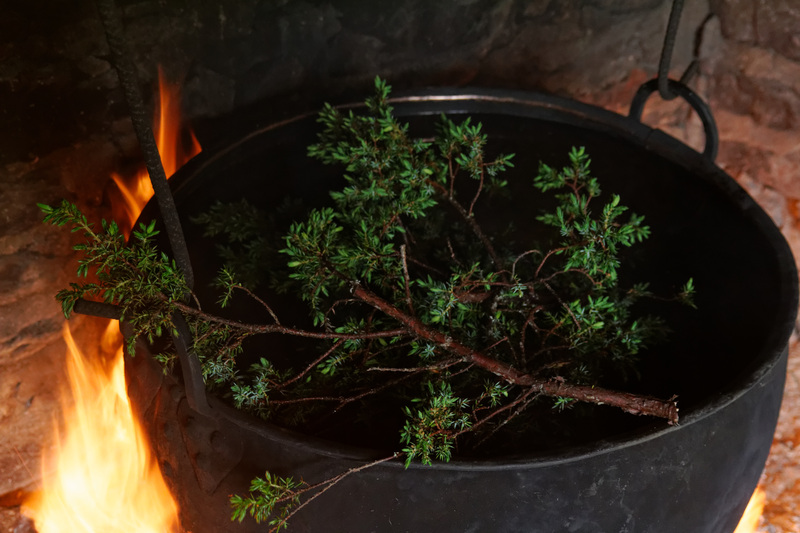
Juniper in the kettle, Innvik |
Then I found questionnaire answers on farmhouse brewing from Westphalia in Germany. Several described the use of juniper infusion to clean the brewing gear. And one talked about boiling juniper branches in the wort. Another used juniper berries in the beer[9]. So the Germans used it, too! Suddenly Denmark was looking like a hole in a continuous tradition. Of course, these two accounts could be an exception, but the Bavarian purity law of 1616 allows juniper[10]. And source upon source claims juniper was part of gruit (medieval pre-hops beer spice mix) as well, so it seems unlikely that these really are exceptional.
Then, quite recently, I started researching Russian farmhouse ale. Videos from 12 hours' drive northeast of Moscow show the brewers cleaning their brewing gear with juniper infusion. "Our disinfectant," they call it[11]. Then I was sent an interview with an old woman 300km east of St. Petersburg. She brewed with juniper infusion, she says[12]. Russian Wikipedia describes juniper infusion as widely used in cleaning wooden vessels, just as in Norway[13]. These things go together, as the tradition for cleaning the brewing vessels with wormwood and then using it in the beer shows in Denmark.
In Norway, after people stopped brewing beer from malts they made "juniper beer" from sugar and juniper berries. In parts of Poland people are making the exact same "beer"[14]. Does that mean they made beer with juniper before? Very possibly. Interestingly, something similar shows up in 19th-century France, a beer-like drink called "genevrette", made from juniper berries and barley[22].
I'm convinced I'm not done uncovering this iceberg yet.

Use of juniper. Gray: in strainer only, white: juniper infusion. Juniper infusion for cleaning not shown. The German examples are buried under black dots. |
Suddenly we're looking at the use of juniper across most of northern and eastern Europe. The evidence dates from the 18th century onwards, but there is no way it spread over an area so vast in a couple of centuries. Or so you'd think, but what about archaeological finds? Behre recounts dozens of them, and he doesn't seem to have picked up anything about juniper[15]. I've read quite a few archaeological reports myself, finding no juniper.
Then, suddenly, lightning struck. Here's Ove Arbo Høeg, the doyen of Norwegian ethnobotany, in his book about juniper. He's discussing the question of when, after the Ice Ages, juniper came back to Norway.
[Juniper] produces enormous amounts of pollen, so one might think pollen analysts would have a rich material for illuminating the immigration history of the species. Unfortunately juniper pollen belongs to the few species whose pollen is very thin-walled and unstable, just like aspen. It can be found in peat and mud samples, but it's known that preservation conditions determine how much of the original pollen remains in the sample. Therefore juniper pollen usually isn't included when the percentages of pollen by species are computed. [16]
Well, that changes the picture, because just about every analysis that I've seen of ancient beer remains is based on pollen analysis. But here Arbo Høeg is saying that if there had been any juniper in the original beer the pollen would be gone by now. Of course, that doesn't mean the juniper was necessarily there. It just means the analysis would be likely to miss it if it were.
There's also the additional problem that while finds of seeds and fruits of gale and hops with grain tend to make archaeologists assume they're looking at beer production, the presence of juniper means little to them. So it's possible that some finds have been overlooked.

Natural range of Juniperus communis, MPF, Wikimedia Commons |
So archaeological finds didn't necessarily rule out that juniper use was ancient, but neither did they support it. It was at this point I recalled that I'd seen analyses of ancient beer remains by chemical methods, and not pollen analysis. These were done by Patrick McGovern[17]. Out of the two finds he analyzed thoroughly and then concluded were beer, no less than two contained juniper. These were from 1400 BCE and 200 BCE.
And as for why juniper is not used in our two "deviant" countries, the UK and Denmark, Arbo Høeg has this to say:
In Denmark there are only a few regions in which juniper is widespread enough to play anything remotely like the role it has in Norwegian folklore. This applies even more so to Great Britain. [16]
So it's beginning to like those places where juniper was not used are those places where there basically isn't enough of it. I'll need to do more research to confirm that, though.
And is there a connection with the use of juniper in Dutch genever (which gave rise to the English gin)? There's a strict limit to how old genever can be, since distillation did not become widespread in Europe before roughly the 12th century[23]. At that point people had been brewing farmhouse ale for at least two millennia already. Did the use of juniper in liquor come from an earlier tradition of using it in beer? It's possible.
What is clear is that for the last centuries, juniper has been extremely widespread in farmhouse brewing, to the point that no other spice except hops can compete at all. In my database, out of 489 accounts, 455 use hops, 287 use juniper, and the runner-up is wormwood with 22. You could almost call juniper "the farmhouse hop".
Juniper has definitely been widely used in farmhouse brewing in Norway, Sweden, Finland, Estonia, and Latvia. It's also definitely been used, probably widely, in Germany, Russia, and Austria. There are signs it may also include France and Poland, but we'll see. This is what I mean about the beer community somehow having missed a huge story.
What's more, it's possible that juniper was the main brewing herb from the Stone Age onwards, and that hops only eclipsed it at some point after the end of the Middle Ages. That, however, is going to be substantially harder to prove.
Sources
[1] Brewing and Beer Traditions in Norway, Odd Nordland, Universitetsforlaget, Oslo, 1969.
[2] Historisk beskrivelse over Øvre Tellemarken, Engelbret Michaelsen Resen Mandt, 1777, p107.
[3] Beskrivelse over Sillejords præstegiæld i øvre Tellemarken i Norge, Hans Jacob Wille, Gyldendal, Copenhagen, 1786.
[4] Afhandling om Ølbrygningen i sin fulde Udstrækning, Johan Christian Molbech, Gyldendal, Copenhagen, 1796, p65.
[5] En fullständig swensk hushållsbok, Reinerus Broocman, Norrköping, 1736, p17-19.
[6] Vom Steinbier, Raimund Dürnwirth, in Carinthia I., 95, Klagenfurt 1905, p10-19, quoting a source from 1822.
[7] Traditional German Steinbier, Phil Rahn and Chuck Skypeck, Zymurgy 17, no 4, 1994, quoting a source from 1906.
[8] Die Staatswirthschafts-chemie, als Leitfaden zum Behufe der öffentlichen Vorlesungen über diesen, Philipp Ritter von Holger, Wien, 1843.
[9] Volkskundliche Kommission für Westfalen, manuscripts M121 (undated, but describes the period 1890-1910) and M313, dated 1956.
[10] Streit ums Bier in Bayern, Birgit Speckle, Waxmann, 2000. Strictly speaking the law in question is "Die bayrische Landesverordnung von 1616".
[11] Verkhneenangskie pivovariy ili, Lyudmila Mikhailovna Kharyukova, amateur Youtube video.
[12] Бабушкин рассказ, Youtube video of unknown provenance. Interview with Nadezhda Prokofyevna of Senno, Leningrad Oblast, Russia.
[13] Можжевельник обыкновенный, Russian wikipedia.
[14] Juniper Beer in Poland: The Story of the Revival of a Traditional Beverage, Madej et al, Journal of Ethnobiology, 34(1):84-103. 2014. DOI 10.2993/0278-0771-34.1.84.
[15] The history of beer additives in Europe - a review, Behre, K.-E. 1999. Vegetation History and Archaeobotany. 8:35-48.
[16] Eineren i norsk natur og tradisjon, Ove Arbo Høeg, Norsk skogbruksmuseum, Elverum, 1996. ISBN 8290660170.
[17] A biomolecular archaeological approach to ‘Nordic grog’, McGovern et al, Danish Journal of Archaeology, 2013.
[18] Pors och andra humleersättningar och ölkryddor i äldre tider, Nils von Hofsten, Volume 36 of Acta Academiae Regiae Gustavi Adolphi, Uppsala, 1960.
[19] Vom Halm zum Fass, Matti Räsänen, Kansatieteellinen arkisto, Helsinki, 1975.
[20] Gotlandsdricka, Anders Salomonsson, Skrifter utg. av Etnologiska sällskapet i Lund, Lund, 1979.
[21] Physisk, oeconomisk og statistisk Beskrivelse over Spydeberg Præstegield, Jacob Nicolai Wilse, Christiania, 1779.
[22] Arboretum Et Fruticetum Britannicum: Or, The Trees and Shrubs of Britain, Volume 4, John Claudius Loudon, 1844, p2493.
[23] Distilled beverage, Wikipedia article.
Acknowledgements
Thank you to Per Kornhall, Geir Ove Grønmo, Boak & Bailey, Merryn Dineley, Andreas Krennmair, and Partizan Bryanski for sending me some of these sources. Many thanks to Martynas Savickis for help with some of the Russian material. Thanks to Morten Rønningen, Stan Hieronymus, and Merryn Dineley for feedback on the text. All remaining errors are mine, obviously.
Similar posts
Nordic grog
The origins of beer brewing in Scandinavia are lost in the mists of pre-history, and today we have very little evidence of how it began
Read | 2015-02-09 20:44
The Early History of Hops
One of the biggest mysteries in the history of beer is where and when people started using hops in beer
Read | 2022-12-06 10:15
Mead: a Norwegian tradition?
Most people think of the vikings as big drinkers of mead, and believe that Norway has a long and strong tradition for mead-making
Read | 2018-04-15 12:16
Comments
Martyn Cornell - 2017-02-02 09:08:14
Fascinating. C Anne Wilson's Food and Drink in Britain (1973) mentions that even before Dutch gin, juniber was "often" an ingredient in Elizabethan aqua vitae or aqua composita, but evidence of juniper used in ale in Britain does seem to be non-existent. The bushes/trees are found across a wide area in Britain, but only in local spots within that area.
Lars Marius Garshol - 2017-02-02 09:16:57
Thank you!
I think the scarcity of juniper in the UK pretty much explains this. I've been in contact with a couple of people who want to brew Norwegian-style farmhouse ale in the UK, and they've struggled to find juniper. Juniper is not very amenable to farming, either. So clearly using juniper in the UK wasn't ever really going to work. I guess it's no more complicated than that.
1 - 2017-02-02 10:28:35
I see you read mtf ;)
Benedikt Rausch - 2017-02-02 10:53:37
Spruce was used in Germany (Goslar) for cleaning and lautering through for Gose making. They also used wormwood for spicing. Source (http://www.bierauseigenerkueche.de/Goslarer%20Gose.html Really nice article! Thanks for the info!
merryn dineley - 2017-02-02 13:14:08
So much to think about here. Very interesting research. I think, on Orkney, today, there is one juniper tree. In someone's garden. So I have been told. We have yet to find it. I have no idea about how many there may have been here in past times. Or whether they were here at all.
Lars Marius Garshol - 2017-02-02 16:06:36
@1: Yeah, I do follow MTF. Lots of interesting stuff there.
@Benedikt: That's interesting! It's actually the first example of traditional use for spruce that I've seen. I'll check that out. Thank you!
@Merryn: The two accounts of Orkney brewing you sent don't mention juniper at all. The third one doesn't, either. So it doesn't sound like there was any tradition for juniper there, but who knows.
Marco Daane - 2017-02-02 16:08:43
Terribly interesting. In the Netherlands, just to add to your collection, I've not found anything like this, but most farmhouse ales must have been very local or they were not regarded as something special that you would write about. Moreover, from the 16th century onwards most of them were produced and delivered by town brewers due to brewing laws, although there have been illegal brews - yeah but try to find anything about them, after all, how do you keep your illegal stuff secret. But juniper has been used by brewers in these regions. In the middle ages it was indeed a possible part of gruit. There must have been many different gruit mixtures though, with or without juniper. In the 17th century juniper beer was one of a range of supposed medical herbal beers. Juniper in that context was regarded as good against the gout or failure of kidneys and bladder. Later it was used in hot beer, a kettle mixture of beer, honey, syrup or sugar, a wee dram, eggs and several herbs and spices. It kept you warm on a winter's day, especially during ice skating. But there were also different recipes for those warm beers, not using juniper.
Mika Laitinen - 2017-02-03 12:08:01
That is an impressive set of evidence and a fascinating discovery.
Where juniper grows, it is an extremely handy brewing ingredient. Branches can be picked any time of the year just before the brew day from a nearby forest. Works for filtering, cleaning and flavor. Likely people figured that out quite early. The problem is that it grows very slowly and is difficult to cultivate. If lots of brewers start using juniper branches, the plants can become scarce.
From a historical point of view hops are less obvious brewing ingredient. The hop flowers are useless if they are not harvested, dried and stored really carefully. But they are more suitable to large scale brewing.
Perhaps juniper is not always mentioned in the questionaires, because some brewers considered it more like a filtering aid and cleaning agent, rather than an ingredient.
Brewing Classical - 2017-02-04 10:20:30
Thank you for this very interesting read. Pliny the Elder (Book 14, Chapter 19) describes the use of juniper berries and juniper wood in the boiling of grape must (for wine). This was not a common practice, but it demonstrates the use of juniper in the production of alcoholic beverages in Europe at least 2000 years ago.
offhand - 2017-02-04 16:35:48
I commend you for taking one anonymous commenters criticism on board (from several months ago). Your articles and entire blog have become infinitely better in 2017 now that you are citing the information you source for your posts. Your beer blog has a much more professional feel to it now and is much more absorbing to read. Keep up the good work.
Lars Marius Garshol - 2017-02-05 05:45:38
@Marco: It seems that in many countries farmhouse ale has been regarded as something too ordinary to write about, which is why I'm grateful for the work of ethnologists, who have documented this kind of thing in detail. So if it existed in the Netherlands (it very likely did) it should be documented in the ethnological literature.
@Mika: Thank you! Yes, I totally agree that hops are well-suited to large-scale brewing and to trade, while juniper is more practical for home brewing. Juniper is mentioned in nearly all questionnaires, it's just that quite few respondents forget it when asked "what herbs other than hops do you use?" I think the reason is that they think of it as a key ingredient, and not an exotic herb.
@Brewing Classical: Thank you! That's interesting! It widens the area of juniper usage even more. Huh.
Beattie - 2017-02-05 17:38:47
Thanks for a really interesting piece.
I can see I'm not the only one to have had the idea of trying to brew with juniper in the UK, and like others have hit the stumbling block of there just not being much of it about.
I would be interested in accounts of farmhouse brewing in Scotland, though. Could you point towards the sources you found?
Lars Marius Garshol - 2017-02-06 02:21:25
@Beattie: There are two main ones that Merryn Dineley tipped me about. One is Island Saga: The Story of North Ronaldsay, Mary A. Scott, Alex Reid & Son, 1967. The other is Reminiscences of an Orkney Parish, John Firth, W.R. Rendall, Stromness, 1920. In both books there's only a few pages on beer brewing.
Bo Eriksson - 2017-02-09 07:19:38
Before thee, Master, I bow my head... So much knowledge, thank you very much, Lars!
Wolfram - 2017-02-15 13:50:46
Thank-you for the article. I've been brewing with juniper at home for my own "ancient beer" experiments. I am planning on spending 3 weeks in Lithuania in June. Thanks to your blog, looking for and sampling various brewing treasures will be a fun part of my trip.
qq - 2017-02-15 17:53:53
I'm sure I've read of juniper being used in old English gruits, but I'm not at home so can't check my books.
However, as a biologist that juniper distribution in Britain doesn't make much sense. The southeast corner of England is dry, bits of it get as little rainfall as Israel, and the geology is mostly chalk so the soils are alkaline. Conversely the north of Scotland gets huge amounts of rain and the soil is generally acid on top of sandstone, granite or schist. So why is juniper in Sussex and the Highlands, but not in between? It can't be a factor of rainfall or soil type.
Also, the UK was almost entirely covered in ice 10,000 years ago, before being reforested by trees originating in the Pyrenees. So any juniper in Scotland would have migrated from Spain through England to get to Scotland.
So my question would be - is the lack of juniper in central Britain caused by man? Did invading ??Anglo-Saxons and Vikings?? drink so much beer that they wiped out local sources of juniper?
It's an interesting thought, that would also apply to other areas of Europe. AIUI most of the commercial juniper berry crop now comes from Albania.
Steve Gauthier - 2018-11-20 16:03:49
Hello Lars,
I’m hoping you can point me in the right direction.
I’m looking to brew a sahti here in Canada, using local juniper.
We’re going to build a trough to use for the branches, but I’m wonderi if you can point us to a source on the proper way to use it, and not just stick branches in the mash.
Steve
Lars Marius - 2018-11-20 17:57:47
@Steve: You can see some photos here: http://www.posbeer.org/oppaat/sahti/equipment.php
Typically you have a very long step mash first, then transfer to the kuurna to lauter through the juniper branches. So they are the filter. The little wooden staves go underneath the branches, to make a clear space at the bottom where the wort can run freely.
This page has some very good advice. The guy behind it wrote a book in Finnish on sahti brewing. He's visited lots of sahti brewers, brewed his own many, many times, etc etc: https://www.brewingnordic.com/farmhouse-ales/sahti-recipe/
Victor Esteve - 2019-05-29 17:01:07
Excellent read!
Steve hatton - 2019-10-18 04:39:55
Great read. Nice logic. Im in the French alps where there is lots of juniper. I will definitely try some in the next brew. Thanks.
Jacqueline Fletcher - 2022-06-24 10:33:41
Thank you so much for this article. I'm currently living in France, in the Mediterranean submontane and there is some juniper here but not really enough considering it is listed as native to this bioregion. This is a very interesting bioregion anyway for a wide variety of reasons, one of them being the history of migrations for economic and religious reasons, the harsh life for peasant farming communities on steep terrain only accessible by mule until the roads and railways arrived in some parts in the 19th century. For many, mainly Protestants escaping the wrath of Catholic kings, the remoteness was the main attraction, but, of course, they must have been very resourceful given the unpredictability of rainfall and poor, rocky soils. This means that agriculture has transformed the landscape time and again over the centuries, maybe millennia (there are remains of a Merovingian settlement and a Roman bridge not far away).
There is also a native Ulex species in my books though I've never encountered it and it interests me because I know that in my native Scotland, gorse ('whin' in Scottish) was used for flavouring beer for centuries before hops were introduced.
Thanks again for such an informative and enjoyable article. It has fired my desire to know more and I will look for more resources in French for juniper and gorse and their uses.
Dennis - 2024-04-10 21:06:41
>> In my database, out of 489 accounts, 455 use hops, 287 use juniper, and the runner-up is wormwood with 22. You could almost call juniper "the farmhouse hop".
Man, the more juniper and wormwood they use - the more reason to call it gruit, not beer. There's a fine line, innit? So, all those sahti, gotlandsdricka and other sur thangs are still ales but... not really beers, eh?
Laurentius Zamoyski - 2025-03-27 16:37:01
Oh, yes. In Poland, there are regions that produce a traditional "piwo jałowcowe" or "wino jałowcowe". From what I gather, these are quite low in ABV.